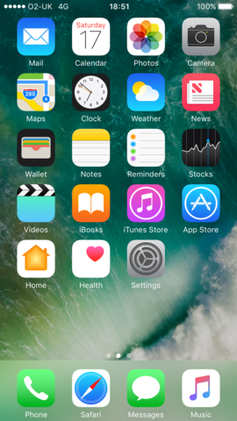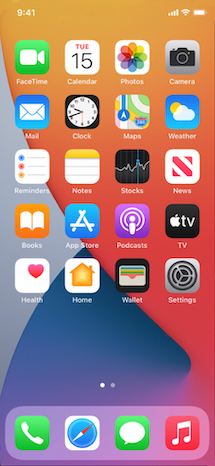
A smartphone, often simply called a phone, is a mobile device that combines the functionality of a traditional mobile phone with advanced computing capabilities. It typically has a touchscreen interface, allowing users to access a wide range of applications and services, such as web browsing, email, and social media, as well as multimedia playback and streaming. Smartphones have built-in cameras, GPS navigation, and support for various communication methods, including voice calls, text messaging, and internet-based messaging apps.

A light-on-dark color scheme, better known as dark mode, dark theme or night mode, is a color scheme that uses light-colored text, icons, and graphical user interface elements on a dark background. It is often discussed in terms of computer user interface design and web design. Many modern websites and operating systems offer the user an optional light-on-dark display mode.

iOS is a mobile operating system developed by Apple exclusively for its devices. It was unveiled in January 2007 for the first-generation iPhone, which launched in June 2007. Major versions of iOS are released annually; the current stable version, iOS 18, was released to the public on September 16, 2024.

Apple Wallet is a digital wallet developed by Apple Inc. and included with iOS and watchOS that allows users to store Wallet passes such as coupons, boarding passes, student ID cards, government ID cards, business credentials, resort passes, car keys, home keys, event tickets, public transportation passes, store cards, and – starting with iOS 8.1 – credit cards, and debit cards for use via Apple Pay.

Redshift is an application that adjusts the computer display's color temperature based upon the time of day. The program is free software, and is intended to reduce eye strain as well as insomnia.

OS X Yosemite is the eleventh major release of macOS, Apple Inc.'s desktop and server operating system for Macintosh computers.

watchOS is the operating system of the Apple Watch, developed by Apple Inc. It is based on iOS, the operating system used by the iPhone, and has many similar features. It was released on April 24, 2015, along with the Apple Watch, the only device that runs watchOS. watchOS exposes an API called WatchKit for developer use.

HomeKit, also known as Apple Home, is a software framework and communication protocol developed by Apple Inc. that lets users configure, communicate with and control smart-home appliances using Apple devices. It provides users with a way to automatically discover such devices and configure them. By designing rooms, items and actions in HomeKit, users can enable automations in the home through a voice command to Siri or through Apple's Home app or third party apps. With HomeKit, developers are able to create complex applications in order to manage accessories at a high level.

iOS 9 is the ninth major release of the iOS mobile operating system developed by Apple Inc., being the successor to iOS 8. It was announced at the company's Worldwide Developers Conference on June 8, 2015, and was released on September 16, 2015. It was succeeded by iOS 10 on September 13, 2016.

iOS 10 is the tenth major release of the iOS mobile operating system developed by Apple Inc., being the successor to iOS 9. It was announced at the company's Worldwide Developers Conference on June 13, 2016, and was released on September 13, 2016. It was succeeded by iOS 11 on September 19, 2017.

macOS Sierra is the thirteenth major release of macOS, Apple Inc.'s desktop and server operating system for Macintosh computers. The name "macOS" stems from the intention to unify the operating system's name with that of iOS, watchOS and tvOS. Sierra is named after the Sierra Nevada mountain range in California and Nevada. Specifically, Lone Pine Peak is the location for macOS Sierra's default wallpaper. Its major new features concern Continuity, iCloud, and windowing, as well as support for Apple Pay and Siri.

Weather is a weather forecast app developed by Apple Inc., available on iOS since the release of the iPhone and iPhone OS 1 in 2007. It allows users to see the conditions, forecast, temperature, and other related metrics of the device's current location, as well as a number of other cities. A version of Weather is also available for watchOS; however, it is limited in functionality. Weather was made available on more devices across the Apple ecosystem with the releases of iPadOS 16 and macOS Ventura, where weather data from Apple was previously only available as a widget or through Siri.
Night Shift is a built in software feature of iOS and macOS. It was introduced in 2016-2017 into iOS in iOS 9.3 and into macOS in macOS Sierra 10.12.4. The feature changes the color temperature of the display towards the warmer part of the color spectrum that reduces some of the blue light from the screen. Apple claims that the feature may help users have a better night's sleep by filtering blue wavelengths from the display, which suppress melatonin biosynthesis. The feature is similar to the functionality f.lux provides.

The iPhone X is a smartphone that was developed and marketed by Apple Inc. It is part of the 11th generation of the iPhone. Available for pre-order from October 27, 2017, it was released on November 3, 2017. The naming of the iPhone X marked the 10th anniversary of the iPhone.

The OnePlus 5T is an Android-based smartphone produced, released and marketed by OnePlus. It was unveiled on 16 November 2017 via a live streamed press event which aired on YouTube. It went on sale on 21 November 2017. It is an incremental update to its predecessor, the OnePlus 5, which was unveiled only five months prior. Some notable changes that are featured, includes, a larger display and thinner bezels found on the device with the repositioning of the fingerprint scanner from the front to the rear panel. On 17 May 2018 the OnePlus 5T was succeeded by the OnePlus 6.

macOS Mojave is the fifteenth major release of macOS, Apple Inc.'s desktop operating system for Macintosh computers. Mojave was announced at Apple's Worldwide Developers Conference on June 4, 2018, and was released to the public on September 24, 2018. The operating system's name refers to the Mojave Desert, and is part of a series of California-themed names that began with OS X Mavericks. It succeeded macOS High Sierra and was followed by macOS Catalina. macOS Mojave is the last version of macOS that features the iTunes and Dashboard apps.

iOS 14 is the fourteenth major release of the iOS mobile operating system developed by Apple for the iPhone and iPod touch lines. Announced at the company's Worldwide Developers Conference on June 22, 2020 as the successor to iOS 13, it was released to the public on September 16, 2020. It was succeeded by iOS 15 on September 20, 2021.

iOS 15 is the fifteenth major release of the iOS mobile operating system developed by Apple for its iPhone and iPod Touch lines of products. It was announced at the company's Worldwide Developers Conference on June 7, 2021, as the successor to iOS 14 and released to the public on September 20, 2021.
The marketing of Apple Inc. encompasses the company's advertising, distribution, and branding. After Steve Jobs returned to Apple in 1997, he made industrial design a key element of the company's branding strategy. Apple's public image has been shaped by several acclaimed advertisements made in partnership with TBWA\Chiat\Day, including 1984 and Get a Mac. Many of Apple's product announcements occur during keynote speeches the company gives several times a year, at Apple Special Events or at Apple's Worldwide Developers Conference, that help reinforce Apple's brand.



















